Distribution
![]()
![]() Notes & Interesting Articles
Notes & Interesting Articles ![]() Nikon Overview
Nikon Overview ![]() Pricing
Pricing ![]()
![]()
![]() Special Optics
Special Optics

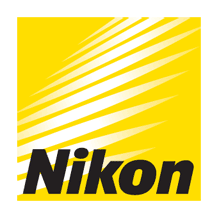
Nikon UV-105, 105mm f/4.5 Multispectral Imaging Lens
Specialized, limited availability Nikon product distributed worldwide by Company Seven
While it’s high resolution and transmission deep into the UV most distinguishes the UV-105 from most other lenses, this is also a superb performer in the visible (VIS) and into infrared (IR) portions of the spectrum too.
Right: current production model UV-105 (PF10545MF-UV), formerly marketed as the UV-Nikkor 105mm lens. Shown with covers as distributed by Company Seven (52,383 bytes).
This product was originally announced in 1984 as the Nikon 105mm f/4.5 UV-Micro-Nikkor, and from September 1985 it was marketed as the Nikon UV-Nikkor, then the lens sold then for $2,200.00 USD, then about half the cost of a full sized car. This lens was originally designed for use with a Nikon single lens reflex (SLR) film camera however, this lens is also compatible with digital SLR and CCD based systems. It projects an image that can fill film or digital sensors as large as the Nikon FX (24 x 36 x 43mm) format.
The Nikon UV-Nikkor lens production was discontinued in 1999. Owing to it’s unique properties and continuing demand, Nikon resumed limited production on 18 November 2005, and while Nikon national distributors (Nikon USA, Nikon Europe, etc.) do not sell or service it owing to very limited demand, the lens is now distributed by Company Seven for sale to most countries world-wide as the PF10545MF-UV, though it is more readily referred to as the UV-105. Company Seven maintains one of these rare lenses on display at our showroom/museum collection. For availability and ordering advice contact Company Seven.
Performance:
In addition to it’s outstanding optical performance throughout the visual spectrum, the lens is most universally acclaimed for it’s designed usefulness deep into the ultraviolet (UV-C), through the visual, and up into the IR at 900nm. The UV-Nikkor provides a transition wavelength of 220nm allowing the full bandpass of long wave, medium, and even some short wave ultraviolet. There is no need to change focus of the UV-Nikkor when moving from visible to ultraviolet modes because it’s focus in the ultraviolet coincides perfectly with the visual focus. However, a moderate focus shift may be necessary as one passes from the visible into the IR; for this there is an indicator of IR shift is on the lens Distance scale. The UV-105 is fully free of any 'hot spot' as is associated with some other multispectral optics. The transmission is just under 60 percent at 220nm, rising to peak at between 320nm to 400nm with transmission at 66 percent, and from there it remains above 60 percent well into the infrared. Furthermore, this lens has become the preferred choice over alternatives by experienced technical people who require the best performance well into the UV, and a lens that can hold up well mechanically too over many years of service. As related by one customer who compared some alternative UV lenses:
Components:
This lens is made up with six UV grade optical elements with the first three made of Fused Silica (Quartz), the remaining are of synthetic Calcium Fluoride (CaF2). The elements are arranged in six groups. This lens is readily distinguished to the eye from most production Nikon SLR camera lenses due to the lack of conventional antireflection coatings and the concave R1 (front radius) lens surface:
Left: the current packing box provided with the UV-105 lens from Company Seven is not as impressive as that provided with UV-Nikkors made in the 1980s and 1990's
The lens is provided with the Nikon F bayonet mount so it can be attached onto any Nikon SLR camera made since 1959. The AiS mount provides aperture setting feedback to a compatible Nikon camera through the AiS indexing linkage. Alternatively the lens can be attached onto a Nikon Bellows, or other fixtures or specialized instruments that have been adapted to accept the Nikon F mount. There are third party adapters that permit Nikon F mount lenses to be attached to Canon EOS cameras for example. Furthermore, Company Seven can provide the UV-105 with an F to C Mount Adapter so that the lens can be employed either with it's standard Nikon F bayonet mount or with a C mount camera. The C standard is a popular threaded 1.000 inch (25.4 mm) diameter 32 threads per inch specification, designated the "1-32 UN 2A" in the ANSI B1.1 standard, this is popular with many makers of compact CCD cameras that can be used for work well into the ultraviolet.
Another of the other features that distinguishes the UV-105 from other UV lenses made to date (Zeiss UV-Sonnar, and others) is the focus lock. This simple mechanism can be particularly important for OEM and scientific applications where it can be vital to insure there is no accidental mechanical focus shift from frame to frame. So once the lens is focused as desired on the target, you can lock the focus control at that setting.
The Back Focus of the lens is 46.5mm. The UV-105 can be used with either optional Teleconverter lens TC-14B or TC-301, but either of these accessories will inhibit performance in the UV below about 380nm. The forward end of the lens accepts 52mm diameter threaded filters or other fittings (Reversing Ring, etc.).
The UV-105 includes the Nikon LC-52 52mm snap-on Lens Cap, and a simple transparent slip-on Rear Lens Cap. Company Seven does offer the Nikon LF-1 Rear Lens Cap as an option for those who prefer the more upscale cover.
In addition to the options mentioned above other accessories available for the UV-105 include the Nikon Lens Case CL-15S with soft plush lining (interior 3.3 x 4.1 in. - 8.38 x 10.41 cm), the Nikon HS-14 Lens Hood. Filters for UV or IR applications are available too.
Above: UV-105 lens at Company Seven showing (left) near focus configuration, and (right) extended for close Macro focus.
Operating Hints:
This specialty lens does not employ conventional antireflection coatings or glass elements, otherwise these would inhibit the transmission of UV light. Therefore, when using the UV-105 for conventional visible photography, particularly when at high altitude locations, Company Seven recommends use of an optional UV blocking filter such as the Nikon L37c 52mm to prevent a “blue blur” cast from appearing across the image. A side benefit is the protection of the lens front element when this filter is in place, though of course do not forget remove the filter prior to working with the lens in the UV. To protect the UV-105 lens of our customers Company Seven can custom fabricate optional protective flat elements made of UV transmitting fused silica, please enquire.
Be careful, especially when imaging in the UV, that the lens is kept clean of debris or dirt either on or within the optical elements otherwise some contaminants may actually fluoresce! Even barely visible debris can fluoresce and show up as an out of focus ghostly figure. So this is more reason to keep the lens covered and well protected, ideally cased, when not in use. The lens should be stored in an environment or container that is free of humidity, ideally with desiccant that is recharged or replaced as indicated.
Film cameras with certain film types are useable for photography into portions the ultraviolet spectrum. Few modern production digital SLR’s have any capability to work into the UV. Company Seven offers optional specialized systems that can take advantage of the UV coverage of this lens for capturing still images or video, please inquire. This Nikon UV Lens is complemented by our Long Distance Microscopes that can provide resolution down to the sub-micron level even deep into the ultraviolet below 200nm.
The UV-105 PF10545MF–UV is RoHS (Restriction of Hazardous Substances Directive) complaint, meeting the requirements of the European Union directive 2002/95/EC.
The UV–105 (PF10545MF–UV) lens as distributed by Company Seven is accompanied by a warranty protecting the original registered owner against defects of workmanship or materials for a term of two (2) years from date of purchase. This covers defects in workmanship or materials. Any tampering, use in laser applications, exposure to extremes of shock, temperature, or humidity will void the warranty. This warranty is not transferable unless an OEM agreement has been executed.
Ultraviolet (UV) Primer:
UV light is electromagnetic radiation with a wavelength shorter than that of visible light (400 to 700 nm), yet longer than x–rays. UV is considered to span the range from 10 nm to 400 nm. For a representation of the range of uses where the Nikon 105 UV lens is suitable (from 220 to 900 nm) see the following spectrum chart. Note for reference we also show where the Fraunhofer lines (A to K) typically of interest to telescope and lens designers correlate on the spectrum below:
As amazing as it can be to explore the ultraviolet spectrum, this is not child’s play therefore:
When working near shorter wavelengths sources of UV-B or UV-C fully cover the eyes and skin too.
Product Overview:
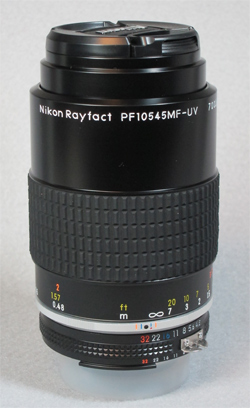 The Nikon UV-105 is a high performance lens that was developed for specialized multispectral applications in the ultraviolet (UV), visible, and infrared portions of the spectrum. The lens was originally envisioned for uses including law enforcement forensic work (popularized by recent television shows), industrial and biomedical applications, as well as uses by artists and the more enthusiastic amateur. This lens became the preferred choice for work in other areas of forensics too including art research (authenticating and restoration for example), medical studies including dermatology, chemical analysis, plasma research, combustion and electric discharge studies, agriculture, environmental monitoring, mineralogy, surveillance, OEM, manufacturing and process control. This remains the most desired UV lens among the more dedicated amateurs who seek to explore the world that is otherwise invisible to the eye.
The Nikon UV-105 is a high performance lens that was developed for specialized multispectral applications in the ultraviolet (UV), visible, and infrared portions of the spectrum. The lens was originally envisioned for uses including law enforcement forensic work (popularized by recent television shows), industrial and biomedical applications, as well as uses by artists and the more enthusiastic amateur. This lens became the preferred choice for work in other areas of forensics too including art research (authenticating and restoration for example), medical studies including dermatology, chemical analysis, plasma research, combustion and electric discharge studies, agriculture, environmental monitoring, mineralogy, surveillance, OEM, manufacturing and process control. This remains the most desired UV lens among the more dedicated amateurs who seek to explore the world that is otherwise invisible to the eye.
Click on image to see enlarged view (118,884 bytes).
with highly uniform illumination across the field, fully free of any 'hot spot' as associated with some other multispectral optics”
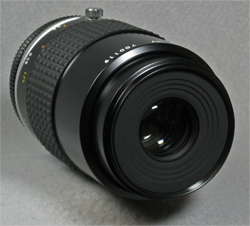 This is an exceptionally sharp and distortion-free 105mm f4.5 variable diaphragm (iris) conventional manually operated lens and with macro capability too. The lens can focus on objects from infinity to as close as 478.5mm (18.8 inches). This lens incorporates Nikon's automatic Close Range Correction (CRC), so at least two separate sets of elements are moving in relation to one other as the lens is focused and this maintains nominal performance even as the working distance changes. The variable diaphragm (iris) can be set to f4.5, 5.6, 8, 11, 16, 22, or 32. At all working distances and at all wavelengths the image is free of aberrations, and there is no distortion. Many users who are highly experienced in UV and IR photography have stated that this is among the sharpest lenses ever made, with highly uniform illumination across the field and virtually no variation in the focus position between visible rays and UV rays. With the optional Nikon PN-11 52.5mm Auto (Ai-S) Extension Tube the lens can attain reproduction ratios of up to 1:2-1.0 at distances as close as 42.9mm (1.69 inches).
This is an exceptionally sharp and distortion-free 105mm f4.5 variable diaphragm (iris) conventional manually operated lens and with macro capability too. The lens can focus on objects from infinity to as close as 478.5mm (18.8 inches). This lens incorporates Nikon's automatic Close Range Correction (CRC), so at least two separate sets of elements are moving in relation to one other as the lens is focused and this maintains nominal performance even as the working distance changes. The variable diaphragm (iris) can be set to f4.5, 5.6, 8, 11, 16, 22, or 32. At all working distances and at all wavelengths the image is free of aberrations, and there is no distortion. Many users who are highly experienced in UV and IR photography have stated that this is among the sharpest lenses ever made, with highly uniform illumination across the field and virtually no variation in the focus position between visible rays and UV rays. With the optional Nikon PN-11 52.5mm Auto (Ai-S) Extension Tube the lens can attain reproduction ratios of up to 1:2-1.0 at distances as close as 42.9mm (1.69 inches).
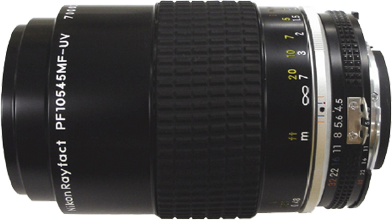
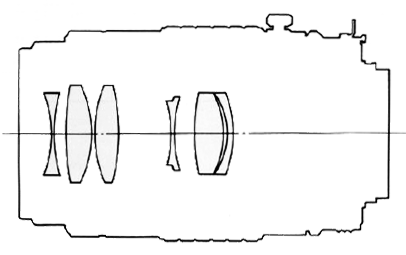
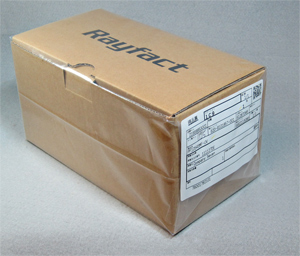 The UV-105 lens is manufactured to the high standards of materials and workmanship that insure high performance, longevity, and reliability; these is among the characteristics that made the Nikon brand the top choice among professional photojournalists and OEM's. With the reintroduction of the UV-105 lens (replacing the UV-Nikkor) there have been no compromises made to suit the fickle nature of the amateur market; this is a professional lens, superbly engineered and crafted to insure long-term durability and high performance. The optics and the mechanical components that comprise the UV-105 lens are manufactured in Japan, assembled there by Nikon's most experienced craftsmen. We do have capability here at Company Seven in the USA to perform routine disassembly, repairs, maintenance of those lenses sold by Company Seven but our parts and the initial assembly originate in Japan.
The UV-105 lens is manufactured to the high standards of materials and workmanship that insure high performance, longevity, and reliability; these is among the characteristics that made the Nikon brand the top choice among professional photojournalists and OEM's. With the reintroduction of the UV-105 lens (replacing the UV-Nikkor) there have been no compromises made to suit the fickle nature of the amateur market; this is a professional lens, superbly engineered and crafted to insure long-term durability and high performance. The optics and the mechanical components that comprise the UV-105 lens are manufactured in Japan, assembled there by Nikon's most experienced craftsmen. We do have capability here at Company Seven in the USA to perform routine disassembly, repairs, maintenance of those lenses sold by Company Seven but our parts and the initial assembly originate in Japan.
however, the UV-105 lens inside is just as capable as ever (48,039 bytes).
Click on image to see enlarged view (455,510 bytes).
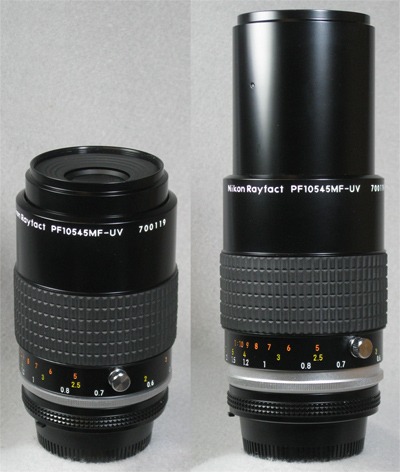
Shown with optional Nikon LF-1 Rear Lens Cap and without provided Nikon LC-52 snap-on Lens Cap (87,412 bytes).
Note the objective lens diameter is much narrower than the 52mm filter threading. Click on image to see enlarged view (300,810 bytes).

Above: Table above expresses visual spectrum, ultraviolet (below 380nm), near infrared (above 700nm)
and optical properties including color correction in Nanometers at various Fraunhofer color lines (C to K).
The visible and invisible worlds are obvious to the Nikon UV–105 lens:
Above: images taken in ultraviolet (350 nm), visible and infrared for comparison (100,722 and 108,277 bytes).
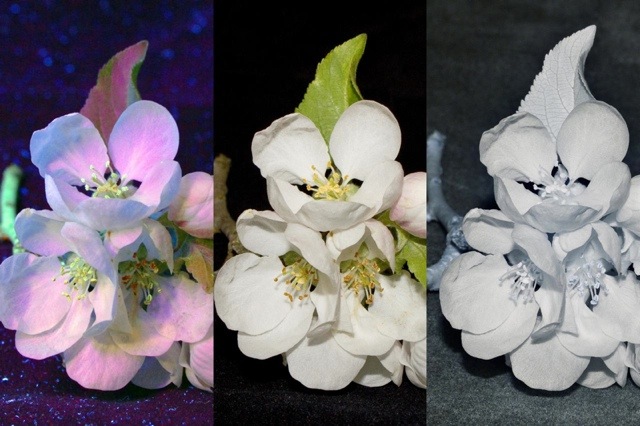
For fun: flower blossoms in UV, visible, IR light
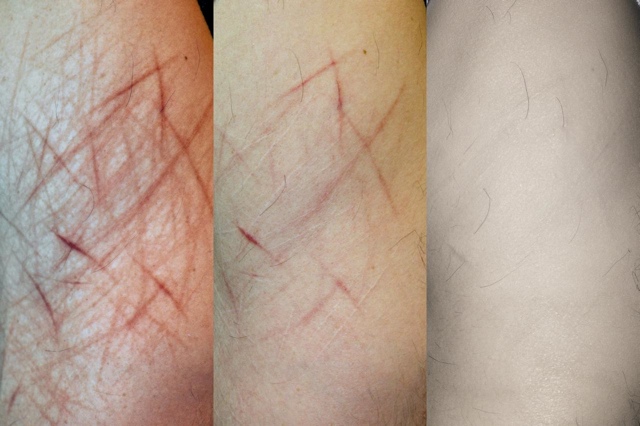
Catching bad guys: scratches in UV, visible, IR light
Images courtesy of R. Horsnell. Click on images to see enlarged views (260,042 and 136,271 bytes).
 WARNING Infrared (IR) and ultraviolet (UV) wavelengths are invisible to the human eye, yet these electromagnetic waves do bear energy and other information. Any structure that absorbs light that incorporates UV and or IR can be damaged by this energy; note how prolonged exposure to sunlight can tan the skin, while prolonged exposure fades or even breaks down materials. The photons of shorter wavelengths carry greater energy than those of longer wavelengths therefore these have the greater potential for causing biological damage. The shorter wavelengths can penetrate the eye or skin cells and can produce heating and energy related biological changes that will modify or destroy cellular DNA; this is among the reasons why UV-C light sources are incorporated into many germicidal (sterilizing) apparatus.
WARNING Infrared (IR) and ultraviolet (UV) wavelengths are invisible to the human eye, yet these electromagnetic waves do bear energy and other information. Any structure that absorbs light that incorporates UV and or IR can be damaged by this energy; note how prolonged exposure to sunlight can tan the skin, while prolonged exposure fades or even breaks down materials. The photons of shorter wavelengths carry greater energy than those of longer wavelengths therefore these have the greater potential for causing biological damage. The shorter wavelengths can penetrate the eye or skin cells and can produce heating and energy related biological changes that will modify or destroy cellular DNA; this is among the reasons why UV-C light sources are incorporated into many germicidal (sterilizing) apparatus.
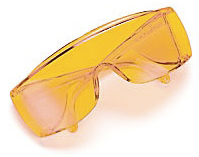 It is vital that suitable eye safety protection be used when working with any UV light source.
It is vital that suitable eye safety protection be used when working with any UV light source.
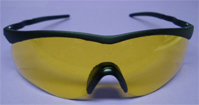
- UV–A is associated with aging of the skin by unprotected exposure to sunlight. When the skin cells’ DNA is damaged by UV radiation then Apoptosis (Type I cell death) is triggered and the skin is replaced; malignant melanoma may occur as a result of indirect DNA damage when the damage is not properly repaired. Proper repair occurs in the majority of DNA damage therefore not every exposure to UV results in cancer. While Earth’s atmosphere provides some protection the exposure to both UV–A and UV–B increases by ten percent (10%) for every 1,000 feet rise in elevation. Residents of those areas of Earth where ozone has been depleted suffer from greater exposure hence a higher percentage of skin and eye damage including cancers.
The Black Light and the Wood’s Lamp are among the more common manmade sources of UV–A, these are used for hobby and entertainment effects with most sources peaking anywhere between 370 to 450 nm. All reptile lamps emit UV–A while some lamps may emit a moderate amount of UV–B too; these are used in terrariums to maintain pet health. While the human eye can not see most of the radiation emitted by a Black Light certain colors and pigments absorb the invisible light then discharge it appearing as a glowing effect. The eerie appearance of posters when observed under UV are one example of this effect. Detergents may contain as much nine percent (9%) phosphorus content, the phosphors absorb UV radiation then expels them as light so that white fabrics shine brilliantly under a Black Light.
- Medium wave UV-B is a higher energy electromagnetic radiation than UV-A hence it can penetrate deeper into the human skin. This increases the likelihood of skin cell DNA absorbing this energy and being modified or destroyed, because of this the letter "B" in UV-B has been associated with "burn" as in sunburn. The ozone layer of Earth’s atmosphere attenuates UV-B however, the amount of UV-B that penetrates the atmosphere to ground level at the equator has historically been about 1,000 times greater than that at the poles. But every one percent (1%) decrease of the ozone layer in the atmosphere results in a two percent (2%) increase in UV-B exposure and a four to six percent (4-6%) increase in carcinoma. Additionally, a correlation between incidence of squamous cell carcinoma of the eyes conjunctiva and exposure to UV–B ultraviolet light has been noted; this can be a local disease process or metastasize to become fatal.
There are Black Light sources employing MgSrAl10O17, Ce phosphors that emit as low as 310 nm peak. Medium wave UV-B sources cause certain bodily fluids to luminesce, so crime scene investigators and forensic laboratories employ these to detect blood, saliva, semen, and other fluids. Medium wave Black Lights are also used to detect anti-counterfeit markers in currency and have many other security applications including screening for counterfeit currency.
- Most of the natural short wave UV–C radiation emitted by the Sun is absorbed in the Earth’s atmosphere so most human exposure to UV–C will originate in artificial sources including Low-Pressure Mercury Arc Lamps. Short wave ultraviolet radiation can also cause sunburn. Short wave ultraviolet is almost completely stopped by most forms of glass or plastic, so quartz (fused silica) or special glasses must be used in the manufacture of short wave light tubes so that the short wave UV–C radiation can pass out of the tube. Short wave ultraviolet is the most popular illumination source for observing mineral fluorescence and phosphorescence producing this in perhaps ninety percent (90%) of fluorescing minerals.
A short wave UV–C sterilizing tube lamps emits radiation that is destructive enough to purify water of living contaminants and to sterilize medical equipment. It has a variety of industrial uses and is considered "germicidal."
- Fluorescence a form of luminescence where the emission of longer wavelengths ceases almost immediately after the excitation source of UV is discontinued.
- Phosphorescence a form of luminescence where the substance will continue to emit (luminesce) for some time after the removal of the excitation source of UV.
- Baader Planetarium U-Filter (shown at right), sometimes referred to as the 'UV' or 'Venus Filter' this is suitable for work in the UV-A. The BPU2 filter is a ultraviolet (UV-A) bandpass filter made so that only light in the 320 to 390 nm portions of the spectrum are transmitted; it will effectively block all else spanning 200nm to 1120nm. This U-Filter transmission peaks with 85% transmission at 350nm with a 70nm bandwidth, and with a 5 stop reduction in the IR portion of the spectrum.
This filter is offered only in 2 inch filter thread, so to adapt the U-Filter onto the UV-105 lens we recommend you also order Company Seven’s custom machined Mark 1 adaptor ring. Note there is no vignetting since the diameter of the front lens element is far smaller than the diameter of the U-Filter; you can see this in the images and optical profile drawings above. The filter can be accommodated by most of our systems too.
- JAA indicates this is an F-Mount lens
- 6 indicting this is a Special Purpose Lens (0 = normal, 1 = wide, 3 = telephoto, etc.)
- 20 indicates this is the 20th lens in the numbering sequence
- 01 indicates this is the revision code / lens features, this may be numbers (old) or more recently characters
Left: packing box of the 1980’s Nikon UV-Nikkor 105mm f/4.5 lens (45,170 bytes).
Click on image to see enlarged view (377,462 bytes).The first production UV-Micro-Nikkor 105mm lens bears the Serial Number 200001. Deliveries commenced in September 1985. Records indicate some 3031 of these lenses were produced between 1985 and 1999, with the final Serial Number being 203031. The service period, that is parts and service support by the Nikon companies including Nikon USA, for the UV-Nikkor 105mm f/4.5 lenses ended in April 2003.
In November 2006 the lens was reintroduced, being made available as a special order item designated “Nikon Rayfact PF10545MF-UV” as explained above in this article. These lenses bear the Rayfact trade name indicating they originate at the Tochigi Nikon Precision Co., Ltd. facilities, one of nineteen domestic Nikon companies in the Nikon Group. The Tochigi factory remains the facility where special lenses for industrial use are made, they also manufacture devices and lenses for IC/LCD steppers and scanners are made. The UV-105 lens is in terms of performance and arrangement identical to the original UV-Micro-Nikkor 105mm f/4.5 lens that was originally introduced by Nikon in September 1985. Though still hand-assembled by the more experienced Nikon technicians, the newer UV-105 lenses benefit from some improvements of manufacturing processes implemented over recent decades. The UV-105 effectively replaces the UV-Nikkor lens in the Nikon line. Because of the limited demand for this lens the Nikon USA (Nikon Inc.) and other Nikon companies do not formally distribute the lens however, Company Seven does sell these to customers world-wide. The Serial Number range for these lenses spans from 700001 up to at least 700304 by the Winter of 2011.
As illustrated in the original instruction manual provided below, the UV-Nikkor included several accessories to facilitate focusing the lens in visible light then to swing a UV transmitting filter into place to capture the image. The provided accessories were:
1. AF-1 Gelatin Filter Holder (PN 2278),
2. UR-2 Filter Element Holder (PN 2398), and
3. Nikon UV Transmitting Filter ("Square UV Filter" PN 2397), pass UV from 220 to 420 nm with peak transmission ≥90% centered at 330nm.The Nikon UV Transmitting filter is visually opaque but allows UV light to pass, rejecting visible light and most but not all infrared too. To put it into use the UV Transmitting Filter is installed into the UR-2 Holder, then this assembly is attached to the front hinged flap of the AF-1 Gelatin Filter Holder. The AF-1 assembly has a male 52mm thread so that it can be attached directly onto the front of the UV-Nikkor (or PF10545MF-UV) lens. For conventional applications the AF-1 accepts optional Gelatin filters between the inner and outer hinged metal frames. Furthermore, for conventional photography the AF-1 front frame has 60mm screw threads to accept the optional Nikon HN-12 Lens Hood, this is a two piece hood accommodating lenses of 35 to 55mm and lenses of 80 to 200mm focal length. For use in UV applications one threads the UR-2 (with the UV Transmitting Filter inserted) onto the 60mm thread of the AF-1. Then to focus visually one lowers the AF-1 front flap with the filter attached out of the way, then once focus is achieved the filter element is moved over the lens to block the visible and most IR light. For infrared photography a suitable optional filter (R60 for example) would be used in place of the UV transmitting filter.
The Nikon price list of May 1986 indicates the list price of the UV-Nikkor 105mm f/4.5 lens was $2,200.00 USD, while the dealer cost $1,430.00. There were some options available for the lens including the Lens Case CL-15S with soft plush lining (interior 3.3 x 4.1 in. - 8.38 x 10.41 cm) and the Nikon HS-14 snap-on Lens Hood. However, for UV work all that is required is included. For lighting Nikon produced a dedicated flash unit based on their powerful Nikon SB-14 but optimized for work in the long UV and near infrared, this is designated the SB-140 UV-IR and it was similarly a special order item too.
1985-1999 Production UV-Nikkor 105mm Lens: images courtesy of Matsuiyastore®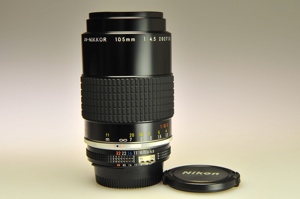
UV-Nikkor standing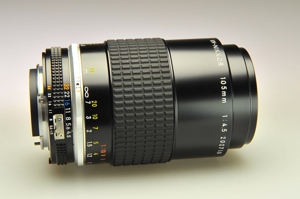
UV-Nikkor side view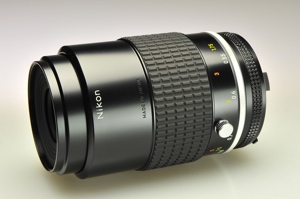
UV-Nikkor opposite side view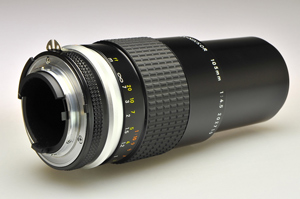
UV-Nikkor close focused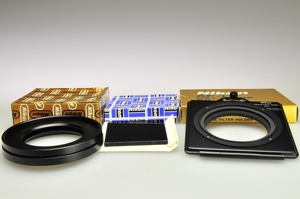
Included accessories: UR-2, Filter, AF-1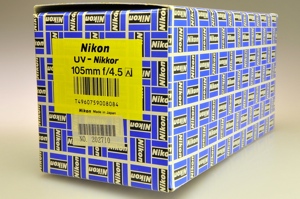
UV-Nikkor packing box and labels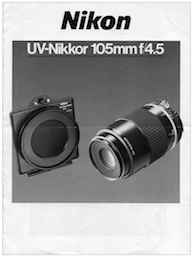
Nikon UV-Nikkor 105mm Lens
illustrated eight page .pdf brochure (1,956,654 bytes)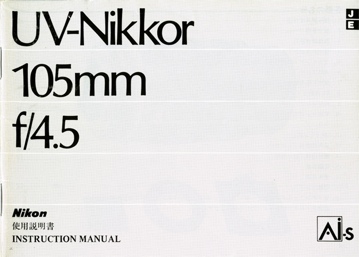
Instruction manual for original production UV-Nikkor of the 1980’s.
.pdf copy of an original in Company Seven’s Archives (1.66 Mb).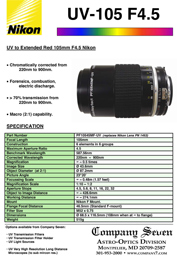
Nikon UV-105 F4.5 Lens
specifications, illustrated one page .pdf brochure (243,425 bytes).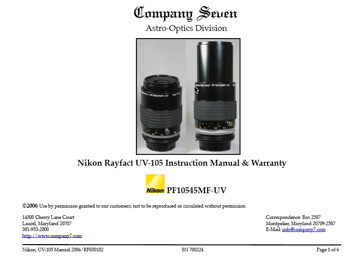
Instruction manual for 2006 production Nikon UV-105 F4.5 Lens
downloadable for customers of Company Seven only by request.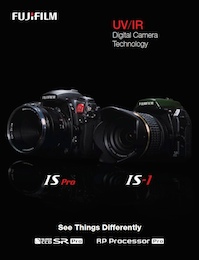
FUJIFILM UV/IR Digital Camera Technology twelve (12) page beautifully color illustrated brochure describing the Fujifilm IS Pro, the last factory produced DSLR camera (to date) specifically made for work in the UV (down to 380nm), and for visible and IR photography. Also covered is the IS-I, another Fuji camera made for IR work. Contents copyright Fujifilm, provided by Company Seven as an Adobe pdf file (4,055,405 bytes).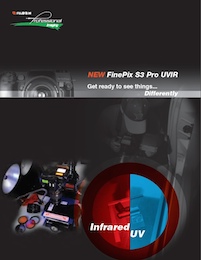
FUJIFILM FinePix S3 Pro UVIR four (4) page color illustrated brochure describing the Fujifilm S3 Pro UVIR, a special production camera. This is the first factory produced DSLR camera made specifically for work down to 350 in the UV, as well as for visible and IR photography. Contents copyright Fujifilm, provided by Company Seven as an Adobe pdf file (1,271,341 bytes).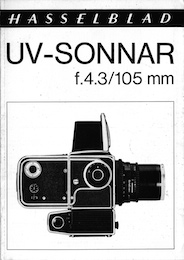
Hasselblad UV-Sonnar f4.3/105 mm complete ten (10) page illustrated booklet describing the lens formerly made by Carl Zeiss. Is an insightful overview of applications for this specialized lens focused on ultraviolet photography. Techniques shown apply to forensics, law enforcement, artworks studies, medical, and other applications. Content scanned from original in our archives in moderate 200 dpi resolution and provided by Company Seven as an Adobe pdf file (27,163,363 bytes).
-
For additional information specifically pertaining to the operation of ultraviolet equipment, radiometers to measure UV, filter and lamp spectral transmission data, and applications techniques browse our UVP Notes & Interesting Articles page.
- "Ultraviolet Spectrum Primer" Illustrated article by Company Seven explaining the ultraviolet (UV) spectrum as it applies to photographing or imaging objects in the UV. The article explains the UV spectrum including UV-A, UV-B and UV-C. Imaging gear including lenses, films and filters.
- naturfotograf.com images and how to site by Bjørn Rørslett
- uvirbloom - ultraviolet floral photography wonderfully and simply presented, with comparison images of white light and UV images
- Ultraviolet Photography techniques and equipment by Enrico Savazzi
- Fluorescent Mineral Society events and Website links
- Fluorescent Minerals techniques and equipment by Enrico Savazzi
- Fluorescent Minerals techniques and minerals for sale by Stuart Schneider
- Reflected Ultraviolet Photography medically oriented site, by Prof. Robin Williams and Gigi Williams
- Ultraviolet Photography of the In Vivo Human Cornea Unmasks the Hudson-Stähli Line and Physiologic Vortex Patterns by the Ophthalmology Section Dept. of Medical and Surgical Sciences and the 2Department of Physiology, University of Otago, Dunedin School of Medicine, New Zealand.
-
 Reflected Ultraviolet Imaging for Forensics Applications by Dr. Austin Richards
Reflected Ultraviolet Imaging for Forensics Applications by Dr. Austin Richards
- Use of Reflective UV Photography to Photo-Document Bruising to Children by Detective Patrick Cochran
- "Ultraviolet Spectrum Primer" Illustrated article by Company Seven explaining the ultraviolet (UV) spectrum as it applies to photographing or imaging objects in the UV. The article explains the UV spectrum including UV-A, UV-B and UV-C. Imaging gear including lenses, films and filters.
UV–A, UV–B, UV–C:
Ultraviolet equipment (lenses, filters, sources) are designed and employed for different purposes, and this is largely dependent on their operating wavelengths within the UV range. Wavelengths are measured in nanometers (one billionth of a meter), with the UV spectrum generally falling between 10 and 400 nanometers (nm). The portions of the UV spectrum the concern our applications with the Nikon UV-105 lens are these three categories: UV-A, UV-B, and UV-C.
| Ultraviolet Spectrum Sectors The UV-105 Can Work With
* the UV-105 can transmit UV effectively down to 220 nm, most but not all of the UV-C. | ||||||||||||||||
|
The long wave UV–A and medium wave UV–B are the types of naturally occurring ultraviolet energy that can be encountered on Earth. The UV–C is encountered only when generated by artificial sources.
Sources, Techniques, and Filters:
Sources Light sources that produce UV in quantities to be useful for imaging include: flash, incandescent, fluorescent, or LED's where there are now DUV–LED's made for work down to about 240nm. The best choice of source will depend on the intended application (UV–A, UV–B, UV–C), and whether or not the subject could be altered or damaged by energy radiating from some sources. It is not a simple matter to adapt conventional light sources for use in the UV since commercial lights usually do not emit sufficient UV to provide good results through a UV transmission filter but we do offer specialized portable, handheld or tabletop, and larger installable UV lamps including high-power UV Grid models made by UVP for example.
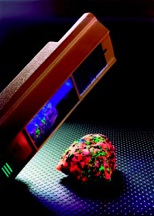 UVP UV-C lamp shown lighting a mineral sample. |
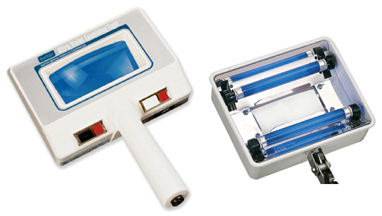 Woods Lamp 365nm UV fluorescent 'Black Light', above and below. Typically used for magnified medical exams. |
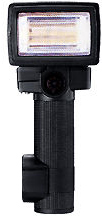 Nikon SB-140 Flash filter not shown |
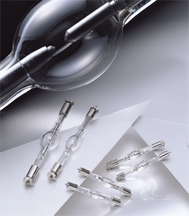 Hammamatsu Xenon or Deuterium lamp bulbs |
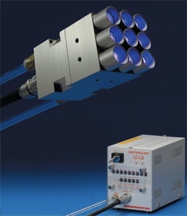 Hammamatsu UV LED with Controller |
Above: examples of common commercial UV sources (20,556, 39,782, 8,118, 10,722 then 58,009 bytes).
Click on images of UVP, Woods Lamp, and Hammamatsu items to see enlarged views (96,926, 103,757, 278,768 and 189,873 bytes).
The lighting sources for field photography or forensics applications should be portable and able to run off of batteries, or the lighting may be AC powered. To freeze the moment and to minimize exposure time of the target to UV sources we prefer the flash unit, though the best rarely go lower than 300nm depending on the supplied UV filter element. There are light systems made specifically for UV that incorporate excitation filtering; you will find information about suppliers for minerals studies, etc. on the Internet. A shade or reflector should be used to better direct the light onto a target and eliminate stray UV light.
Of course safety gear (goggles, etc.) will also be associated with the use of most light sources. So you may want to organized a 'UV Kit' and keep it cased and ready to go.
Techniques in order to obtain the best results when working in the UV one should first understand:
-
Induced Light Emission: when materials are exposed to ultraviolet radiation then that target may luminesce, emitting radiation at longer wavelengths. Some of this can be seen with the naked eye (visible spectrum) or may extend into the infrared. There are two types of luminescence:
Induced Light: this techniques is commonly used for studies of visible or IR fluorescence or phosphorescence and relies on two filters: excitation and blocking filters*. This requires the target be illuminated by a light source that incorporates an excitation filter so that it emits UV light but no infrared or visible. For example this may be a Kodak Wratten 18A filter that appears black and opaque to the naked eye. The camera (or sensor) that is focused onto the object of the study will incorporate a lens that has the capability to pass UV light. The lens will have a filter (Kodak Wratten 2A for example) that blocks UV light but will pass visible fluorescence. So when the target is excited by the light source then the visible or IR fluorescence or phosphorescence will be seen, and the image can be recorded by film or modern digital cameras.
-
* The same filter might be used as either an exciter or as a blocking depending on it’s placement within the system. For example the Kodak Wratten 18A when attached over a flash becomes an excitation filter, or when over the camera lens then functions as a blocking filter.
When working in the UV then the best results will be obtained when working in a dark room, an environment where any source of light in the visible or IR can be shielded or turned off just prior to taking the exposure.
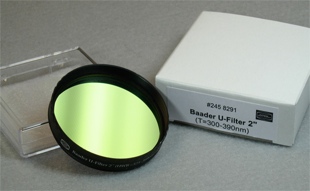 Filters Filters are used to block portions of the spectrum that we do not wish to use, so keep in mind that filters take away but can not add anything.
Filters Filters are used to block portions of the spectrum that we do not wish to use, so keep in mind that filters take away but can not add anything.
The UV Transmission Filter that was formerly made by Nikon and provided with the original UV-Nikkor lens (below) is satisfactory for most applications however, this filter has been discontinued. However, over the recent years newer technology filters have been devised that not only block visible light but also block infrared leakage. Among the newer filters recommended by and sold by Company Seven are:
The Baader U-Filter are visually opaque filters, these reject visible light and most infrared too. As typically employed the UV Transmitting Filter is installed into a filter holder (or cell), then this assembly is attached to the front hinged flap of a camera lens or in-line with our microscopes. To focus visually one slides the filter out of the way, then once focus is achieved the filter element is moved over the lens to block the visible and most IR light. For infrared photography a suitable optional filter (R60 for example) would be used in place of the UV transmitting filter. Of course if one is imaging in real time with a CCD system that displays an image on a screen then one could focus by that aid.
Film, or CCD, or ? Cameras:
Our Nikon 105mm UV lens is suitable for imaging with film or with suitable CCD detectors, or it may be incorporated into a specialized instrument (Radiometer, etc.). Any consumer film or digital camera and film can pick up visible fluorescence, phosphorescence, and tenebrescence. Most film cameras could do well when working into the UV when using specialized films, most notably Eastman Kodak 103-0, but many people have obtained results with artistic and or scientific value using certain conventional black and white films too. Unfortunately, the availability and variety of films is fast diminishing as the photographic industry transitions from film to digital cameras. Of course the digital cameras provide the user with 'instant gratification'; the capability to see their results immediately and not have to pay for and wait for developing.
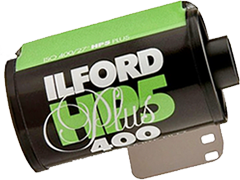 Ilford HP5 Plus Film black & white print emulsion. |
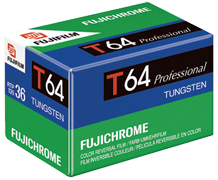 Fujifilm RPT 135 Film tungsten color slide emulsion. |
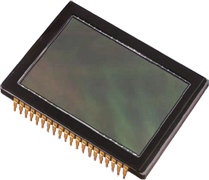 Kodak KAI series Charge Coupled Device (CCD) |
Click on images to see enlarged views (218,292, 260,322 and 300,006 bytes).
The earlier generations of DSLR cameras (including the Nikon D1, D2, D70, D200) employ a charge coupled device (CCD). Depending on the camera model a CCD based DSLR may have enough sensitivity around and below 400nm to be useful in areas beyond fluorescence in the visual spectrum.
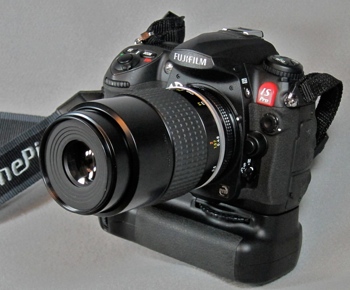 The only company that marketed production DSLR's engineered specifically for work from the UV and into the IR was Fujifilm who in August 2006 introduced the FinePix S3 Pro UVIR and later the FinePix IS Pro, DSLR cameras with factory engineered modifications of hardware and firmware geared especially for law enforcement and scientific applications. These were the world's first production DSLR cameras capable of taking photographs, depending on the lens and filter attached, in the ultraviolet, or visible, or infrared light portions of the spectrum spanning from 350nm (380nm for the IS Pro) to 1 micron.
The only company that marketed production DSLR's engineered specifically for work from the UV and into the IR was Fujifilm who in August 2006 introduced the FinePix S3 Pro UVIR and later the FinePix IS Pro, DSLR cameras with factory engineered modifications of hardware and firmware geared especially for law enforcement and scientific applications. These were the world's first production DSLR cameras capable of taking photographs, depending on the lens and filter attached, in the ultraviolet, or visible, or infrared light portions of the spectrum spanning from 350nm (380nm for the IS Pro) to 1 micron.
Right: The Fujifilm IS Pro may be the last 'production' digital DSLR optimized for UV/IR applications.
Shown at Company Seven with our optional Nikon UV-105 F4.5 lens and battery pack (46,598 bytes).
Click on image to see enlarged view (301,963 bytes).
Among the most noteworthy features of these UVIR cameras are their compatibility with most Nikon F mount autofocus or manual lenses as are modern Nikon DSLR's, including the UV-Nikkor and Nikon UV-105 lenses. The S3 Pro UVIR and IS Pro have since been discontinued.
Just as the CCD based systems grew in pixels to cross the ten megapixel threshold thereby becoming truly attractive for the masses, the DSLR makers transitioned to the complementary metal-oxide-semiconductor (CMOS). The recently developed CMOS requires less power than the CCD hence longer battery life. Unfortunately, the CCD cameras are more sensitive to UV than most current CMOS as these arrays have been engineered to reduce their sensitivity to violet. The changes of sensitivity for the CMOS came about in part so that the detector will be less sensitive to false color (chromatism) that may originate from simpler lenses that will tend to show violet halos surrounding contrasting features; why make the lenses better (and more costly) when the detector can be made to not see some of the problems? While some CCD based cameras have been shown to capture UV down to below 365nm, most drop off approaching 400nm or just below that. The CMOS based Nikon D700 for example incorporates UV cut filters so that light at about 420nm and below is not registered by the CMOS. By 2011 almost every new DSLR in production incorporates either a window (on CCD) or CMOS sensor made to effectively block UV starting at about 420nm and below. So there are few suitable consumer digital cameras to be found new or used that can record the ultraviolet spectrum therefore, there is no practical reason for most mere mortals to pay any premium for these esoteric UV-capable lenses.
therefore, there is no practical reason for most mere mortals to pay any premium for these esoteric UV-capable lenses"
As further evidence of the above statement consider the Nikon L37c filters that were in production until the DSLR's came to dominate the camera market. The L37c filter absorbs ultraviolet wavelengths below about 370 nanometers thereby preventing 'blue blur' of the image mostly caused by atmospheric haze, hence the designation 'L37'. The 'c' suffix indicates the front and rear of the filter has NIC antireflection coatings (the same multi-coatings as on Nikon lenses) to prevent causing reflections or ghost images. So well has the ultraviolet been blocked by modern digital cameras that Nikon no longer offers the L37c filters, instead they now offer multicoated Nikon 'Neutral Color' filter that is similar in it’sprotective aspects to the L37c type of filter but the NC filter does not cut out longer ultraviolet wavelengths.
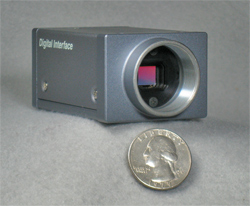 For our industrial and research clientele Company Seven and other companies too do offer digital cameras made specifically for work into the UV. These tend to be monochromatic cameras with comparatively small detector arrays than those found in most consumer DSLR cameras. These UV-capable cameras can usually be provided with a threaded lens mount or a bayonet that will accept most popular formats including the Nikon F-Mount.
For our industrial and research clientele Company Seven and other companies too do offer digital cameras made specifically for work into the UV. These tend to be monochromatic cameras with comparatively small detector arrays than those found in most consumer DSLR cameras. These UV-capable cameras can usually be provided with a threaded lens mount or a bayonet that will accept most popular formats including the Nikon F-Mount.
Left: one of our megapixel CCD cameras incorporating a 2/3 inch diagonal format detector, shown alongside Quarter coin for scale (31,561 bytes).
Click on image to see enlarged view (205,738 bytes).
However, the immediate future does not look good for the hobbyist who seeks to explore UV digital imaging; they will be left searching out used DSLR CCD-based cameras or old stocks of suitable film.
Please contact Company Seven for advice that may be more specific to your requirements.
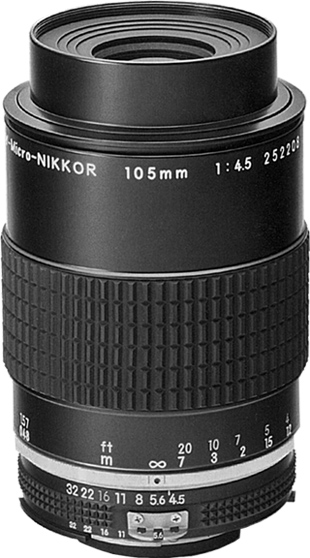 Nikon 105 UV Lens Development And Marketing:
Nikon 105 UV Lens Development And Marketing:
as explained in our discussion of Nikon history, the 1970’s and 1980’s were amazing decades for optical developments. Most of the innovations in camera lens technology over this period could be attributed to improved performance of computers used to model the optical designs, computer assisted manufacturing machines, and to the advanced glass types developed and with consistently higher purity (homogeneity, etc.) that would permit engineers to push the boundaries of lens tech.
Right: UV-Micro-NIKKOR 105mm lens prototype, Serial No. 252208. Shown about life size (68.5mm / 2-11/16 inch diameter). Image size 77,272 bytes.
The team at Nikon that developed what would initially be known as the UV-Micro-Nikkor 105mm f/4.5 lens was led by Wakamiya Takakazu, he was assigned to the Optical Section 1, Optical System Department. The UV-Micro-Nikkor 105mm f/4.5 was not the first UV lens to be made by Nikon, before it were the 55mm f/4 UV Nikkor Auto lens (closely resembling the 55mm f/3.5 Micro) introduced in 1965, that would be followed by other 50mm to 55mm UV lens models. Some twenty years after their original UV lens was introduced, the UV-Micro-Nikkor would be developed. The prototype lens is S/N 252208, designated “105mm f/4.5 UV-Micro”, and this was completed early in 1984. This prototype was based on a modified production Nikon 105mm f/4 Micro Ai-S lens, a five element design in three groups that later was refined into a six element arrangement. The changes to make the 105mm a UV-Nikkor were radical including an optical arrangement that in no way resembled the original conventional Micro lens furthermore, all six lens elements of the UV-Nikkor final design are made of very costly synthetic materials. Finally the conventional multilayer antireflection coatings would inhibit the UV transmission, and so several of the six air-spaced components are coated with a synthetic material to reduce reflections; the resulting overall transmission is approximately 70%.
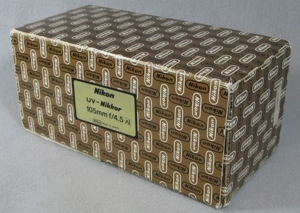 The first production model was designated “UV-Micro-Nikkor 105mm f4.5”, this was announced in April 1985. These could be ordered in most Nikon markets, including in the United States through Nikon Inc. but only by special order as Product No. 1453 NAS. The UV-Nikkor 105mm f/4.5 lens bears the international Nikon Product Code JAA62001:
The first production model was designated “UV-Micro-Nikkor 105mm f4.5”, this was announced in April 1985. These could be ordered in most Nikon markets, including in the United States through Nikon Inc. but only by special order as Product No. 1453 NAS. The UV-Nikkor 105mm f/4.5 lens bears the international Nikon Product Code JAA62001:
Contents Copyright 1994-2017 Company Seven, All Rights Reserved

